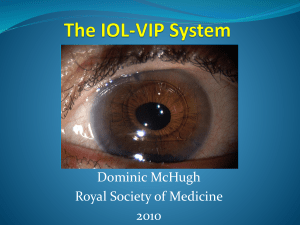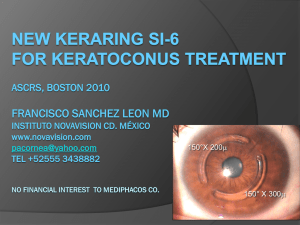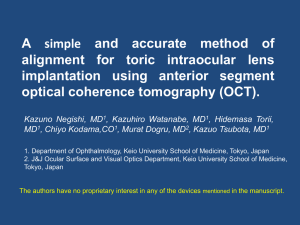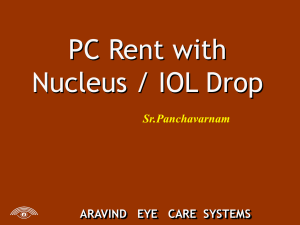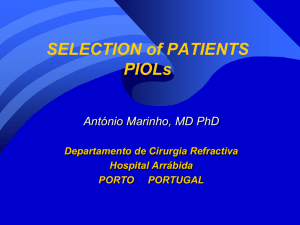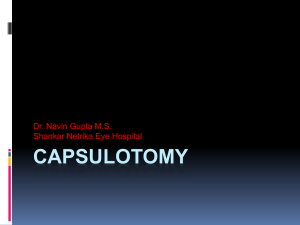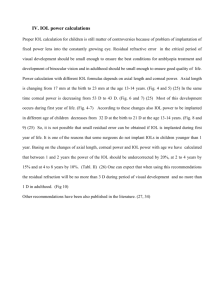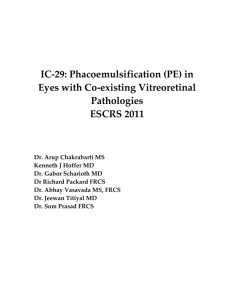IC-44_ Vasavada_Handout
advertisement
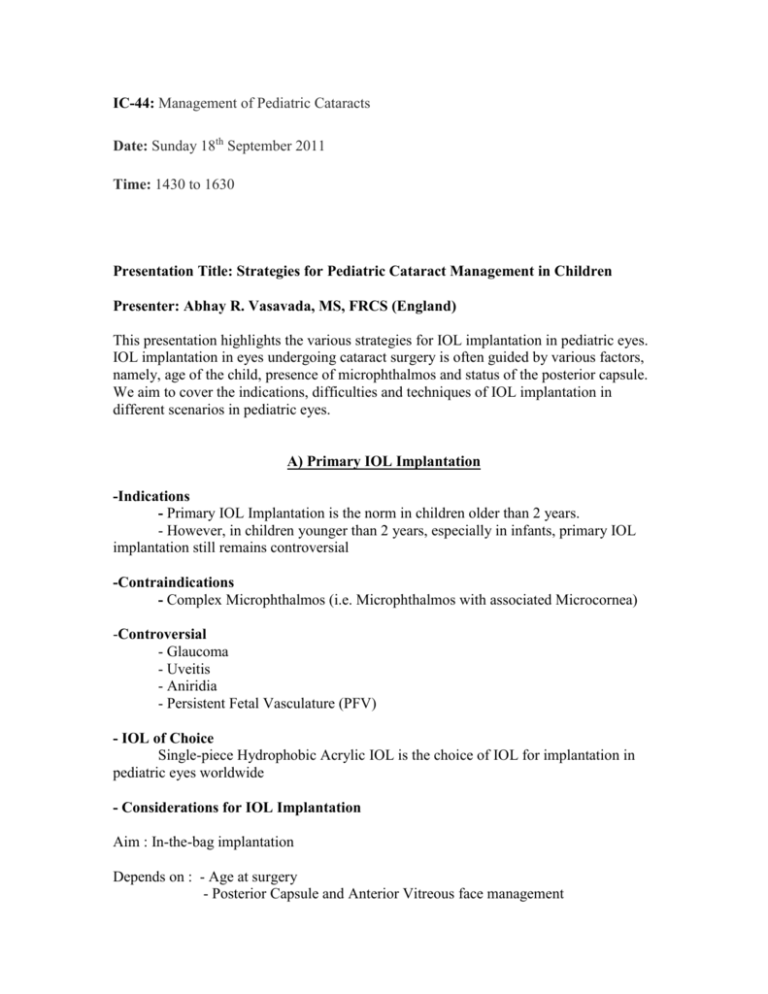
IC-44: Management of Pediatric Cataracts Date: Sunday 18th September 2011 Time: 1430 to 1630 Presentation Title: Strategies for Pediatric Cataract Management in Children Presenter: Abhay R. Vasavada, MS, FRCS (England) This presentation highlights the various strategies for IOL implantation in pediatric eyes. IOL implantation in eyes undergoing cataract surgery is often guided by various factors, namely, age of the child, presence of microphthalmos and status of the posterior capsule. We aim to cover the indications, difficulties and techniques of IOL implantation in different scenarios in pediatric eyes. A) Primary IOL Implantation -Indications - Primary IOL Implantation is the norm in children older than 2 years. - However, in children younger than 2 years, especially in infants, primary IOL implantation still remains controversial -Contraindications - Complex Microphthalmos (i.e. Microphthalmos with associated Microcornea) -Controversial - Glaucoma - Uveitis - Aniridia - Persistent Fetal Vasculature (PFV) - IOL of Choice Single-piece Hydrophobic Acrylic IOL is the choice of IOL for implantation in pediatric eyes worldwide - Considerations for IOL Implantation Aim : In-the-bag implantation Depends on : - Age at surgery - Posterior Capsule and Anterior Vitreous face management - IOL Implantation after PCCC (with or without Anterior Vitrectomy) PCCC alone o After bimanual I/A, a manual posterior capsulorhexis (PCCC) is performed aiming to restrict the size of PCCC around 4 mm o The capsular bag is inflated by injecting Healon/Provisc between the two leaflets of the capsular bag o A single-piece hydrophobic acrylic IOL is injected so that its leading haptic goes in the bag, and the trailing haptic opens in the anterior chamber o Using an IOL dialer, the IOL is manipulated into the capsular bag PCCC and Anterior Vitrectomy o A manual PCCC is performed as described above o This is followed by automated bimanual anterior vitrectomy through the limbal route o The capsular bag is inflated by injecting Healon/Provisc between the two leaflets of the capsular bag o A single-piece hydrophobic acrylic IOL is injected so that its leading haptic goes in the bag, and the trailing haptic opens in the anterior chamber o Using an IOL dialer, the IOL is manipulated into the capsular bag The advantage of this approach is that manual PCCC gives a very strong rhexis margin and the size of the opening can be controlled. This may offer greater IOL stability. - IOL Implantation before PCCC o In very young children (6 months of age or younger) we prefer to first implant the IOL in the bag and then perform a pars plicata posterior vitrectorhexis with anterior vitrectomy o As the first step, IOL is implanted in the bag. o The main incision is sutured o Pars plana entry is made 1.5 mm behind the limbus. Posterior vitrectorhexis with anterior vitrectomy is performed using 23 G vitrector. The advantage of this approach is that it is easier to perform. Often, achieving a manual PCCC of a desired size can be technically challenging. - IOL Implantation with Posterior Capsule Plaque o In case of a large pre-existing posterior capsule plaque, it is often difficult to perform a Manual PCCC o We prefer to perform a partial excision of plaque with vitrectomy. o A nick is made in the posterior capsule using a 26 G needle or a 0.9 mm dual bevel knife. o The plaque is then excised using microincision forceps to create an adequate opening in the posterior capsule o In case of anterior vitreous face disturbance, anterior vitrectomy is performed o IOL is implanted in-the-bag as described above B) Secondary IOL Implantation - Indications - Correction of primary surgical aphakia - Intolerance to glasses/contact lenses - Prerequisites - Good visual potential - Adequate capsular support - Contraindications - Glaucoma - Microphthalmos - Uveitis - Persistent fetal vasculature - Timing of Secondary Implantation - Generally wait until child is atleast 3 years old - Site of IOL Implantation - In-the-bag implantation preferred Sulcus implantation : higher risk of glaucoma, uveitis, retinal complications - Technique for Secondary in-the-bag IOL implantation - A Clear corneal paracentesis incision is made A dispersive OVD (Inj. Viscoat) is injected in the anterior chamber to coat the endothelium followed by Inj. Healon to create space and facilitate further manouevres Preservative-free Triamcinolone (4 mg / 0.1 ml) is injected into the anterior chamber to identify vitreous strands in AC In case of residual vitreous detected, limbal 2-port anterior vitrectomy is performed Most often, in these cases, the anterior and posterior capsule leaflets are fused Try to separate the 2 leaflets by using a blunt instrument (spatula) or viscodissection. In case of severe fibrosis the fibrotic margin can be excised using microscissors The proliferative material between the two leaflets then needs to be aspirated using bimanual I/A - The capsular bag is now inflated with Injection Healon/Provisc and capsular support assessed for in-the-bag implantation If the support is judged adequate a single-piece hydrophobic acrylic IOL is implanted in the capsular bag
